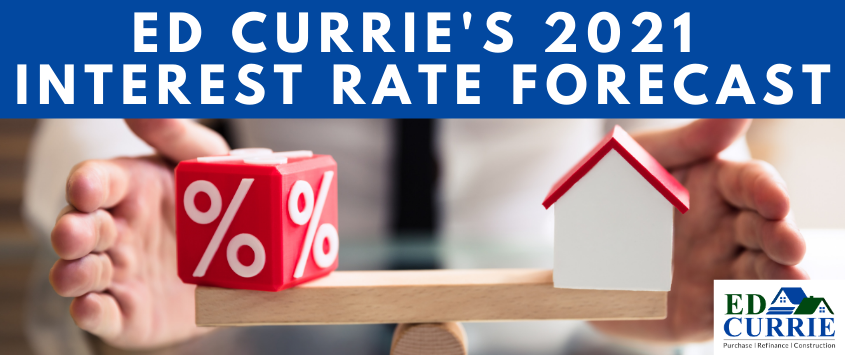This time last year, we are all talking about a virus out of China and the Dems trying to remove President Trump from office. Fast forward a year and, well, we’re still talking about the same thing. But, a lot has happened in between!
My mortgage rate forecast last year was to have rates fall moderately. They fell, but more than moderately. The impact on the global economy of COVID-19 and the Federal Reserve response accounted for a dramatic drop in mortgage rates. Most people were able to refinance at lower rates and some even refinanced more than once.
So what will happen in 2021? Most experts are predicting rates to be moderately higher. While I understand this consensus, I think rates will be mostly flat with the 30-year fixed in the 2.75—3.25 percent range for most of the year.
The Variables
There are always the “knowns” (eg. inflation) and the “unknowns” (eg. a pandemic) that impact interest rates but the items I am looking at this year are:
Inflation
Inflation is bad for interest rates. The Democrats control the presidency, House and Senate. They have been very clear that they want to spend “trillions” for various things. These trillions need to be created from bond offerings and leads to higher rates.
Stock Market
After a historic selloff in March, the stock market has been on a tear. Historically, stocks and bonds fight for the same dollar. When stocks are up, bond prices are down (and rates go up). When stocks go down, bonds prices go up (and rates go down). That relationship has been broken with the Federal Reserve very active in the markets. If the stock market would have a correction, rates could fall albeit for a short period of time.
Economy
Do we really know how the economy is doing? With trillions of dollars of fiscal and monetary support, can the economy stand on its own two feet? We should get a pretty good idea this year.
After another round of stimulus and the rollout of the vaccine, there will be a discovery period to see how the economy is doing. This won’t happen until the end of the year though so the environment will be very supportive for a strong economy. When the economy is strong, rates tend to rise.
“Spreads”
While the previous three items most likely would push rates higher, “spreads” should more than offset them. By “spreads” I mean the spread between the Treasury rates and mortgage rates. Historically the spread between the 10-year Treasury and the 30-year fixed mortgage rate has been about 1.25 percent. So if the 10-year Treasury was at 2.0 percent, the 30-year fixed may be at 3.25 percent.
When there is extremely strong demand for mortgages, that spread widens. In March and April after the initial plunge in rates, we saw mortgage rates 2-4 percent higher than Treasuries. As the demand moderates so do spreads. They have come down quite a bit in the past few months but still have room to tighten further. That means we could see Treasury rates push higher while mortgage rates stay constant.
Regardless of what is being forecasted, don’t wait to make a move if something makes sense right now. If you can save money by refinancing or consolidating debts, don’t wait for a forecasted lower rate that may never materialize.
If you have questions for me or want me to review your account – email me here. For more tips and our latest updates, check us out on Facebook, Twitter, LinkedIn or Pinterest!



